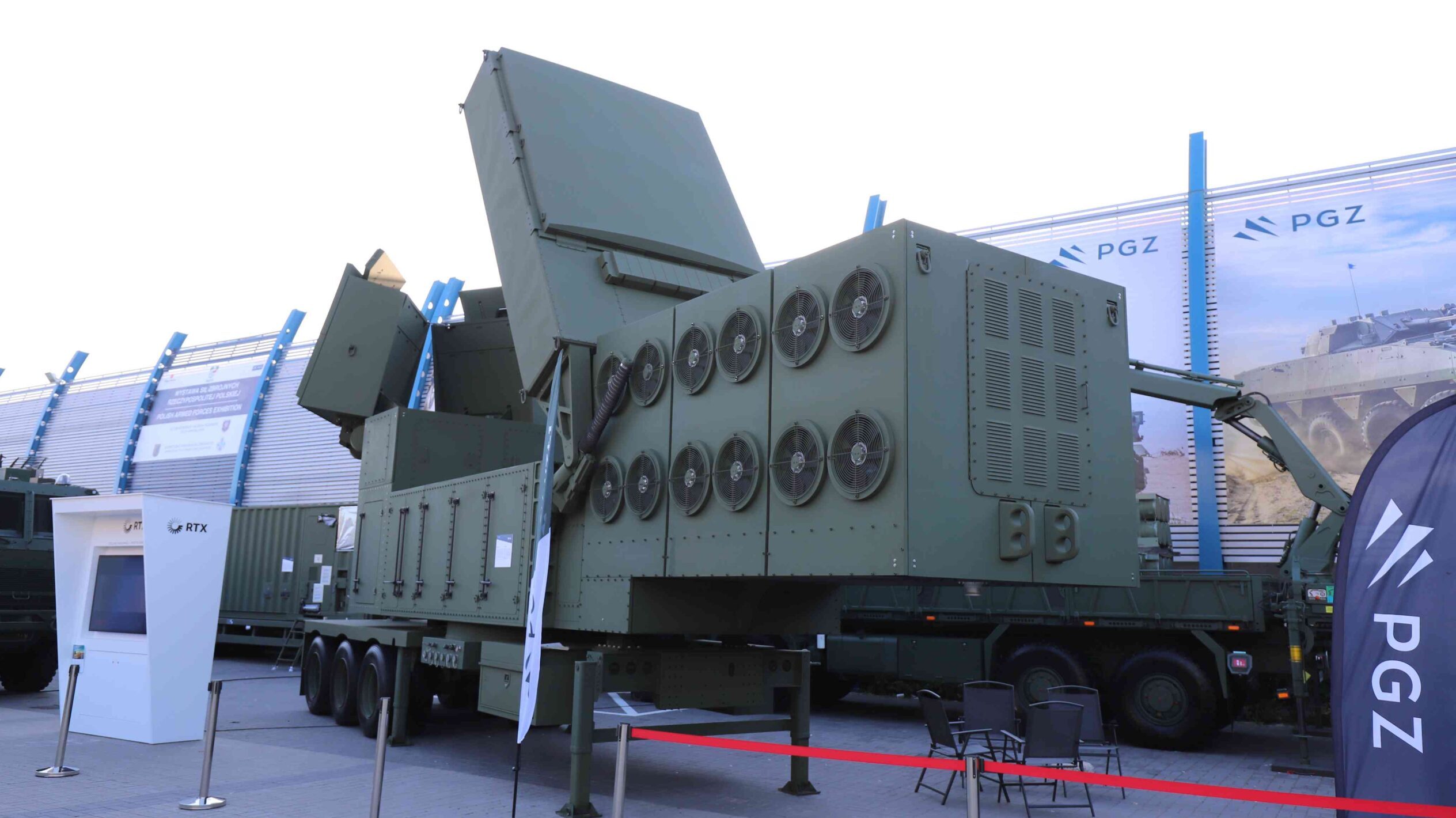
A Raytheon-made LTAMDS radar is presented during Poland’s MSPO 2023 conference. (Barosz Glowacki/Breaking Defense)
KIELCE, Poland — Poland on Tuesday took a series of steps towards its integrated air defense network of the future, including becoming the first international customer for a new US Army radar.
On the first day of the 31st International Defense Industry Exhibition MSPO in Kielce, Minister of National Defense Mariusz Błaszczak, standing next to Polish president Andrzej Duda, signed off on a series of new contracts, collectively worth more than $15.5 billion.
The first set was a series of agreements to help build out the Wisla air and missile defense system, Poland’s name for its Patriot effort. Among them was an agreement to purchase 12 Lower-Tier Air and Missile Defense Sensors (LTAMDS), an RTX-designed Gallium Nitride-based AESA radar system. While the US Army is under contract for six LTAMDS, a foreign customer had yet to sign on.
Alongside those radars, Poland announced it would seek a further 48 Patriot launchers and a stock of PAC-3 missiles, through the US Foreign Military Sales process. Deliveries of the first two batteries under the second phase of the Wisla program will be carried out in 2026 and 2027, and the completion of deliveries is planned for 2029.
Wisla, which will form the backbone of Poland’s missile defense network, will not just be a national security boon for Warsaw. On Aug. 25, RTX and Lockheed Martin reached agreements on industrial offsets worth roughly zł1 billion ($240 million), with a five-year implementation period. Some of that offset will go towards helping set up Poland’s homegrown missile defense efforts.
More offset details emerged at MSPO, with Caroline Touchstone, Poland programs director at Raytheon, saying the “company’s intention is to create partners and suppliers base in Poland. Phase 2 projects will expand existing collaborations with Polish partners from phase 1, and involve building new competences in selected offsets to manufacture and sustain components for LTAMDs radars.”
Offset work related to the LTAMDS deal includes local development of IFF systems (PIT-RADWAR), integration of Energy Storage Assembly (WZE), cables for ESA (WZU), circuit card assembly (CTM), and cooling system sustainment (WZŁ-1).
The MND’s Armament Agency and the PGZ-NAREW Consortium — led by PGZ and including HSW, Jelcz, Mesko, OBR CTM, PCO, PIT-RADWAR, WZŁ No. 1, WZU, WZE and ZM Tarnów — announced two agreements for the delivery of key elements of the Narew SHORAD system, including delivery plans between 2027 and 2035 for over a thousand CAMM-ER missiles and 138 rocket launchers. A technology transfer was also contracted, to ensure the production of both missiles and launchers in Poland, as well as an extensive training and logistics package. According to unofficial numbers circulating at the show, the combined value of that contracts is around zł54 billion (almost $13 billion).
Another contract for the delivery of ZENIT-MP+ Automated Command and Control Posts (ZSD), was concluded between the Armament Agency and the PGZ-PILICA+ Consortium for the delivery, in the years 2025-2029, of 22 Automated Command Posts (ZSD) in the Zenit MP+ configuration. Those systems tie into the Pilica+ VSHORAD missile and artillery system, composed of iLaunchers with CAMM missiles as well as 23mm 2A14 guns and anti-aircraft missiles; the contract for the Pilica+ systems was set up last May. The gross value of the contract is roughly zł650 million ($155 million).
Meanwhile, the Armament Agency and Kongsberg Defense & Aerospace finalized a contract for new Naval Strike Missile (NSM) systems for two more Maritime Missile Units (Morska Jednostka Rakietowa, MJR). Included in that contract are vehicles, launchers and several hundred NSM anti-ship missiles. The gross value of the order is roughly zł8 billion ($1.91 billion), and the deliveries will be made in the years 2026-2032.
The MJR is a unit charged with protecting the main Polish Navy bases, potentially vulnerable spots to a sea landing and important military and industrial facilities located on the coast. It comes equipped with NSM systems integrated on the MJR is able, in cooperation with the Navy, to defend the sea coast, protect sea communication on coastal fairways and support combat activities of the Navy and Land Forces in defense operations. MJR is based on elements of the NSM system integrated with a Jelcz truck chassis.
While not specifically tied to missile defense, there was another contract of note between the Armament Agency and Polish WB Electronics, for the delivery for nearly 1,700 Miniature FlyEye unmanned aerial systems, along with logistics and training packages, as a part of framework agreement. Although not officially announced, it is believed that contract value is about zł 2 billion ($480 million). Delivery will run through 2035.
FlyEye is designed to perform image reconnaissance from the air using EO/IR turrets with cameras enabling image recording. The system has been successfully tested in the Polish Army, where it performs tasks for both the Operational Forces and the Territorial Defense Forces, as well as during military operations in Ukraine.
TAI exec claims 20 Turkish KAAN fighters to be delivered in 2028
Temel Kotil, TAI’s general manager, claimed that the domestically-produced Turkish jet will outperform the F-35 Joint Strike Fighter.


























